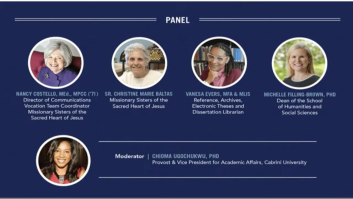Cabrini’s women history common hour event, which was a women’s leadership panel, was in full swing as it was live-streamed on the university’s YouTube channel. It consisted of four main speakers and overall highlighted what women’s history means to the institution. With how Cabrini’s origin revolves around empowered women influencing the generations after them, one could get the sense that the panel event was something that is heavily valued by the college.
The March 10 panel was made up of four main speakers consisting of Nancy Costello, director of communication for the Missionary Sisters of the Sacred Heart of Jesus; Sister Christine Marie Baltas, MSC; Vanesa Evers, reference librarian; and Dr. Michelle Filling-Brown, dean for the school of humanities and social science. It was moderated by Dr. Chioma Ugochukwu, provost and vice president of academic affairs. It comes as no surprise to the many students, professors and staff that attended the event that these were the women leading it, considering how impactful they are daily as they’re a part of an environment that is no stranger to having many women in leadership roles.

As it was broken down into four sections, the speakers had their chance to weigh in on certain figures in particular. It opened up with Costello discussing the legacy of St. Frances Xavier Cabrini and some in-depth facts about her that can be often breezed over.
Mother Cabrini’s unique leadership and way of nurturing people in need, no matter their background, is the foundation the institution is built on and Costello definitely reminded us of that as the common hour began. As it is well known that the college was at one point an all-women school that derived from a female founding president in 1957. The next topic they transitioned to reminded us exactly how far the school has come in terms of the student body and academic programs.
Baltas took the time to weigh in on how much of a mentor and inspiring religious figure that Mother Cabrini was for Mother Ursula, which influenced the leadership and character of Mother Ursula while she served as president. She went into depth on how she walked in her footsteps then talked about her own memories as the dean of students years ago, that’s only a fraction of the great legacy she carries with her.

“My favorite part was the interaction I got to have with the students,” Sister Baltas said. “However, it wasn’t always fun and games because there were challenging times when I had to deal with certain situations, but now me, those students, and the other staff from that time can laugh back on those days with how it was overall filled with fond memories.”
Even with all of the great memories that are known around campus, there are some figures and moments that may go unnoticed from past archives, and that’s where Vanesa Evers comes into play. Her work as the reference, archives, electronic theses, and dissertation librarian has been underway since she arrived at Cabrini six months ago. Not only has she been digitizing the college’s archives, but she also has taken pride in finding glimpses of diversity throughout the decades.
As she spoke, she let it be known that she wants to bring people, clubs and moments to the forefront that have gone forgotten or underrepresented. During the event, she particularly weighed in on a former Catholic nun who served as a Dean for Academic Affairs in the early ’90s, Dr. Mary Antoinette “Toni” Rodez Schiesler. In a separate interview, Evers discussed how she first started seeing somewhat of a population of black students as she looked at archives in the ’70s and ’80s, alongside the fact that the Black Student Alliance was a group that has been long established before it was Black Student Union.
“It was really about bringing some more historical relevance to someone who has become somewhat of a hidden figure in Cabrini’s history,” Evers said. “Especially when considering that she was the first black academic dean at this college.” Based on Ever’s critical research it appears that Schiesler was quite the force for unifying students when it came time to. She was just doing what she could to make the campus an even more positive, safer place for everyone to learn, regardless of one’s background and ethnicity.
Evers brought up the instance of when Schiesler supported the Black Student Alliance when they held a sit-in in the president’s office in 1990, because they didn’t feel as if they were getting the same support from certain offices and departments at the school. One could conclude that Schiesler was an impactful figure that Evers had to dig up facts about to present as an example of someone who may tend to go under noticed but should never be, which also helped the expansion of diversity on campus decades ago.
Filling-Brown talked about the overall scope of the legacy of female leaders at Cabrini and its importance when considering the start and growth of this forever expanding college. Filling-Brown also talked about the history and ongoing fight when it comes to equal opportunities for all women in workspaces and them holding this event that talked about and consisted of hardworking women that have been influential, can only furthermore inspire and pave the way for women to keep excelling for decades to come.


